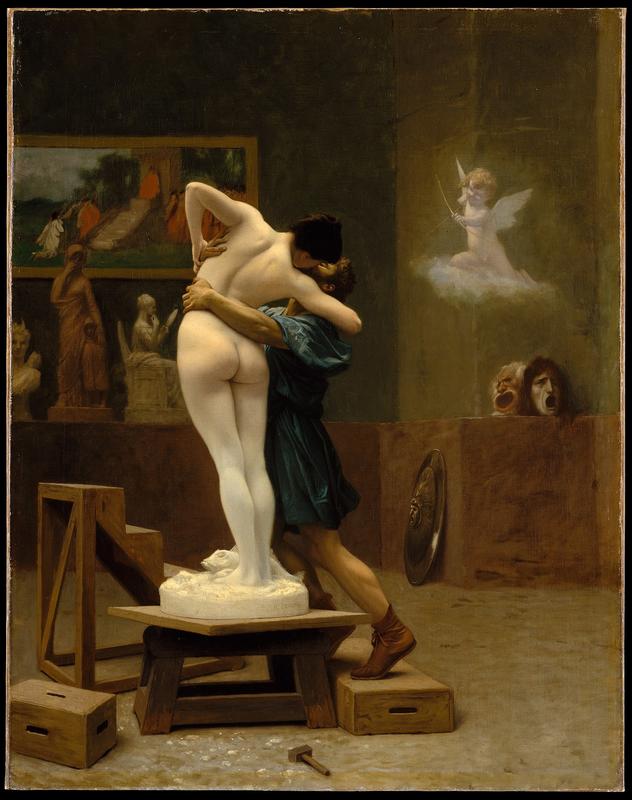More about Pygmalion and Galatea

Sr. Contributor
Take a lesson from Pygmalion and Galatea: if you can’t find the perfect woman, then just make one!
Comprised of 15 separate books and nearly 12,000 lines of poetry, Ovid’s Metamorphoses is really long – I mean, an ancient Roman epic poem and a foundational work of Western literature. In Metamorphoses, Ovid tells 250 of the strangest myths that revolve around the themes of transformation and love. Cupid, the wily son of Venus, is a recurring character who serves as the personification of love. But instead of just minding his business and kissing his own mom, Ovid’s Cupid flies around and causes trouble for all of the other characters, inspiring them to commit crazy acts in the name of love. Although only a measly 54 lines in the whole opus, the story of Pygmalion and Galatea has inspired many subsequent artworks, including this slightly worrisome painting by Jean-Léon Gérôme.
Obviously burdened with a range of complexes (as many characters from Greek mythology often were), Pygmalion was a king from the Greek island of Cyprus who never married because he believed that women were wicked. Real nice. Pygmalion carved a beautiful woman made of ivory and fell in love with his creation. He did a great job – just look at that booty! He was soon kissing and caressing his sculpture on the daily and even clothing her and giving her gifts. Pygmalion must have realized that playing dress-up with a statue was starting to get weird, so he made an offering to Venus, the goddess of love, for a wife as beautiful as the woman he had carved, whom he named Galatea. Venus decided to grant the wish, and the next time he kissed the statue, Galatea transformed from an ivory sculpture into a mortal woman, married Pygmalion, and bore his son.
But what was Galatea’s take on this situation? It’s not like Pygmalion asked her if she wanted to become a woman just to be his lover. Gérôme’s obsession with the Pygmalion myth reveals that this painting is a tad alarming for feminists everywhere. In addition to this work, Gérôme painted as many as five other versions of the ancient lovestruck sculptor, made a sculpture of Pygmalion kissing Galatea, and shows this painting in the background of two later paintings. What comes out in the Met’s painting that isn’t as apparent in the all-white, sculptural version is that Gérôme shows Galatea slowly coming to life. The pinkness of her newfound human flesh spreads from where Pygmalion kisses her down to the rest of her body. Upon closer inspection, it becomes evident that Gérôme is showing us the moment just before Cupid strikes Galatea with his arrow. Technically, Galatea does not necessarily love Pygmalion back yet. The way she grabs his arm screams, “Get off!” In this moment, she’s just a girl getting creeped on, and she can’t even get away from this dude because her legs are still frozen in ivory. How rude!
The weirdness doesn’t end there. Gérôme supposedly modeled the background of this painting on his own studio. The myth was definitely important to Gérôme, and it almost seems like he fancied himself to be a Pygmalion of sorts. Although this painting is not as explicit as the time Thomas Hart Benton purposely modeled a creepy old man after his own father, the message is still pretty clear. Don’t you just love when artists use myths to conceal their own pervy ways?
Sources
- Ovid. Metamorphoses. Translated by Anthony S. Kline. University of Virginia, 2000. http://ovid.lib.virginia.edu/trans/Ovhome.htm#askline. Accessed May 1, 2017.
- The Metropolitan Museum of Art. “Pygmalion and Galatea.” http://www.metmuseum.org/art/collection/search/436483. Accessed May 1, 2017.
- Tinterow, Gary. The Metropolitan Museum of Art Vol. 8, Modern Europe. New York: The Metropolitan Museum of Art, 1987.
- Wolf, Norbert. The Art of the Salon: The Triumph of 19th Century Painting. Munich: Prestel, 2012.











